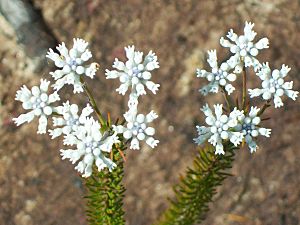Conospermum facts for kids
Quick facts for kids Conospermum |
|
|---|---|
 |
|
| Conospermum ericifolium | |
| Scientific classification |
|
| Kingdom: | Plantae |
| Clade: | Tracheophytes |
| Clade: | Angiosperms |
| Clade: | Eudicots |
| Order: | Proteales |
| Family: | Proteaceae |
| Subfamily: | Proteoideae |
| Tribe: | Conospermeae |
| Subtribe: | Conosperminae |
| Genus: | Conospermum Sm. |
Conospermum is a group of about 50 types of plants. They are all found only in Australia. People often call them smokebushes. This is because their fluffy blue or grey flowers look like puffs of smoke from far away. Smokebushes have a special way that insects help them spread pollen. Most of these plants grow in Western Australia. While they are not often grown in gardens, some types are picked for flower bouquets.
Contents
What Smokebushes Look Like
Smokebushes can be small bushes or even small trees. They usually grow from about 0.3 meters (1 foot) to 4 meters (13 feet) tall. Their leaves are often simple, long, or shaped like an egg. The edges of the leaves are smooth, without any teeth.
The flowers of smokebushes have both male and female parts. They grow in bunches or spikes, with a few or many flowers together. These flowers can be white, pink, blue, grey, or cream-colored. After the flowers, a small nut grows. This nut usually has a ring of hairs at its bottom.
How Smokebushes Got Their Name
The group of plants called Conospermum was first officially described in 1798. This was done by a botanist named James Edward Smith. The name Conospermum comes from two Ancient Greek words. "Kônos" means "cone," and "spérma" means "seed." This name refers to the cone shape of the plant's nut.
People call them smokebushes because their grey flowers look like smoke rising from the plant. The first type of smokebush described was the long leaf smokebush (C. longifolium).
Where Smokebushes Grow
You can find Conospermum plants in all the main states of Australia. Most of the different types grow in the southwest part of Western Australia. However, six types are found in New South Wales, and one type grows in Tasmania.
How Smokebushes Are Pollinated
Smokebush flowers are pollinated by insects. This means insects help them spread pollen so new seeds can grow. Their flowers are quite special. When a flower opens, a part called the style is pressed down.
When an insect lands on the flower, the style quickly flicks from one side to the other. As it flicks, it collects pollen from the insect and also puts a sticky substance on the insect. Then, the parts that hold pollen "explode," covering the insect with more pollen. This quick flick can be strong enough to surprise very small insects.
Some bees from the group Leioproctus are very important for smokebushes. These bees, like L. conospermi, L. pappus, and L. tomentosus, only eat nectar and pollen from Conospermum plants. Some of these bees even look like they are camouflaged. They have white eyes, milky wings, and white hair on their bodies. This close relationship between the bees and the plants is a great example of co-evolution.
Even ants can help pollinate smokebushes. This is unusual for plants. A study in 2020 showed that ants carry a lot of pollen. They also help the C. undulatum plant produce seeds.
Growing Smokebushes
Smokebushes are not very common in horticulture, which means they are not often grown in gardens. However, some types, especially those from Western Australia, have very pretty flowers. The western types are hard to grow from seeds or cuttings. The eastern types are not as popular for gardening.
Four types of smokebushes are used in the cut flower industry. These include the summer smokebush (C. crassinervium), plume smokebush (C. incurvum), common smokebush (C. stoechadis), and tree smokebush (C. triplinervium). Most of these flowers are picked from wild plants. It is hard to grow them on farms, but there is some information on how to grow six types for commercial use.
Types of Smokebushes
- Conospermum acerosum
- Conospermum amoenum
- Conospermum boreale
- Conospermum brachyphyllum
- Conospermum bracteosum
- Conospermum brownii
- Conospermum burgessiorum
- Conospermum caeruleum
- Conospermum canaliculatum
- Conospermum capitatum
- Conospermum cinereum
- Conospermum coerulescens
- Conospermum crassinervium
- Conospermum croniniae
- Conospermum densiflorum
- Conospermum distichum
- Conospermum eatoniae
- Conospermum ellipticum
- Conospermum ephedroides
- Conospermum ericifolium
- Conospermum filifolium
- Conospermum flexuosum
- Conospermum floribundum
- Conospermum galeatum
- Conospermum glumaceum
- Conospermum hookeri
- Conospermum huegelii
- Conospermum incurvum
- Conospermum leianthum
- Conospermum longifolium
- Conospermum microflorum
- Conospermum mitchellii
- Conospermum multispicatum
- Conospermum nervosum
- Conospermum paniculatum
- Conospermum patens
- Conospermum petiolare
- Conospermum polycephalum
- Conospermum quadripetalum
- Conospermum scaposum
- Conospermum sigmoideum
- Conospermum spectabile
- Conospermum sphacelatum
- Conospermum stoechadis
- Conospermum taxifolium
- Conospermum tenuifolium
- Conospermum teretifolium
- Conospermum toddii
- Conospermum triplinervium
- Conospermum undulatum
- Conospermum unilaterale
- Conospermum wycherleyi
See also
 In Spanish: Conospermum para niños
In Spanish: Conospermum para niños

